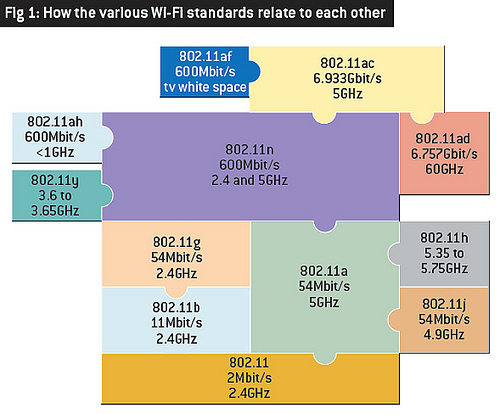IEEE 802.11ah is a wireless networking protocol that is an amendment of the IEEE 802.11-2007 wireless networking standard. It utilizes sub 1 GHz license-exempt bands to provide extended range Wi-Fi networks, compared to conventional Wi-Fi networks operating in the 2.4 GHz and 5 GHz bands. It also benefits from lower energy consumption, allowing the creation of large groups of stations or sensors that cooperate to share the signal, supporting the concept of the Internet of Things (IoT). The protocol is intended to be competitive with Bluetooth with its low power consumption, but with a wider coverage range.
The standard is expected to be finalized and arrive in 2016, with chips and systems based on 802.11ah hitting the market as early as 2015.
In January 2016, the Wi-Fi alliance announced an extension of 802.11ah to be called Wi-Fi HaLow, pronounced "HAY-Low"
Description
A benefit of 802.11ah is extended range, making it useful for rural communications and offloading cell phone tower traffic. The other purpose of the protocol is to allow low rate 802.11 wireless stations to be used in the sub-gigahertz spectrum. The protocol is one of the IEEE 802.11 technologies which is the most different from the LAN model, especially concerning medium contention. A prominent aspect of 802.11ah is the behaviour of stations that are grouped to minimize contention on the air media, use relay to extend their reach, use little power thanks to predefined wake/doze periods, are still able to send data at high speed under some negotiated conditions and use sectored antennas. It uses the 802.11a/g specification that is down sampled to provide 26 channels, each of them able to provide 100 kbit/s throughput. It can cover a one-kilometer radius. It aims at providing connectivity to thousands of devices under an access point. The protocol supports machine to machine (M2M) markets, like smart metering.
Relay Access Point
A Relay Access Point (AP) is an entity that logically consists of a Relay and a networking station (STA), or client. The relay function allows an AP and stations to exchange frames with one another by the way of a relay. The introduction of a relay allows stations to use higher MCSs (Modulation and Coding Schemes) and reduce the time stations will stay in Active mode. This improves battery life of stations. Relay stations may also provide connectivity for stations located outside the coverage of the AP. There is an overhead cost on overall network efficiency and increased complexity with the use of relay stations. To limit this overhead, the relaying function shall be bi-directional and limited to two hops only.
Power saving
Power saving stations are divided into two classes: TIM stations and non-TIM stations. TIM stations periodically receive information about buffered traffic for them from the access point in so-called TIM information element, hence the name. Non-TIM stations use the new Target Wake Time mechanism which allows to reduce signaling overhead. [7]
Target Wake Time
Target Wake Time (TWT) is a function that permits an AP to define a specific time or set of times for individual stations to access the medium. The STA (client) and the AP exchange information that includes an expected activity duration to allow the AP to control the amount of contention and overlap among competing STA. The AP can protect the expected duration of activity with various protection mechanisms. The use of TWT is negotiated between an AP and a STA. Target Wake Time may be used to reduce network energy consumption, as stations that use it can enter a doze state until their TWT arrives.
Restricted Access Window
Restricted Access Window allows partitioning of the stations within a Basic Service Set (BSS) into groups and restricting channel access only to stations belonging to a given group at any given time period. It helps to reduce contention and to avoid simultaneous transmissions from a large number of stations hidden from each other.
Bi Directional TXOP
Bi Directional TXOP allows an AP and non-AP (STA or client) to exchange a sequence of uplink and downlink frames during a reserved time (transmit opportunity or TXOP). This operation mode is intended to reduce the number of contention-based channel accesses, improve channel efficiency by minimizing the number of frame exchanges required for uplink and downlink data frames, and enable stations to extend battery lifetime by keeping Awake times short. This continuous frame exchange is done both uplink and downlink between the pair of stations. In earlier versions of the standard Bi Directional TXOP was called Speed Frame Exchange.
Sectorization
The partition of the coverage area of a Basic Service Set (BSS) into sectors, each containing a subset of stations, is called sectorization. This partitioning is achieved through a set of antennas or a set of synthesized antenna beams to cover different sectors of the BSS. The goal of the sectorization is to reduce medium contention or interference by the reduced number of stations within a sector and/or to allow spatial sharing among overlapping BSS (OBSS) APs or stations.
Comparison with 802.11af
Another WLAN standard for sub 1 GHz bands is IEEE 802.11af which, as opposed to 802.11ah which operates in license-exempt bands, operates in TV white space spectrum in the VHF and UHF bands between 54 and 790 MHz using cognitive radio technology.

